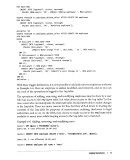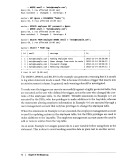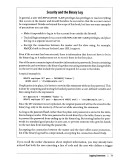Foreword for the Second Edition
Foreword for the First Edition
Preface
PartⅠ.High Availability and Scalability
1.Introduction
What's This Replication Stuff, Anyway?
So, Backups Are Not Needed Then?
What's With All the Monitoring?
Is There Anything Else I Can Read?
Conclusion
2.MySQL Replicant Library
Basic Classes and Functions
Supporting Different Operating Systems
Servers
Server Roles
Conclusion
3.MySQL Replication Fundamentals
Basic Steps in Replication
Configuring the Master
Configuring the Slave
Connecting the Master and Slave
A Brieflntroduction to the Binary Log
What's Recorded in the Binary Log
Watching Replication in Action
The Binary Log's Structure and Content
Adding Slaves
Cloning the Master
Cloning a Slave
Scripting the Clone Operation
Performing Common Tasks with Replication
Reporting
Conclusion
4.The Binary Log
Structure of the Binary Log
Binlog Event Structure
Event Checksums
Logging Statements
Logging Data Manipulation Language Statements
Logging Data Definition Language Statements
Logging Queries
LOAD DATA INFILE Statements
Binary Log Filters
Triggers, Events, and Stored Routines
Stored Procedures
Stored Functions
Events
Special Constructions
Nontransactional Changes and Error Handling
Logging Transactions
Transaction Cache
Distributed Transaction Processing Using XA
Binary Log Group Commit
Row-Based Replication
Enabling Row-based Replication
Using Mixed Mode
Binary Log Management
The Binary Log and Crash Safety
Binlog File Rotation
Incidents
Purging the Binlog File
The mysqlbinlog Utility
Basic Usage
Interpreting Events
Binary Log Options and Variables
Options for Row-Based Replication
……
PartⅡ.Monitoring and Managing
A.Replication Tips and Tricks
B.A GTID Implementation
Index
![高可用性MySQL 《高可用性MySQL》[76M]百度网盘|pdf下载|亲测有效](/365baixing/uploads/s0309/55651013N620d8feb.jpg)
![《高可用性MySQL》[76M]百度网盘|pdf下载|亲测有效](/365baixing/uploads/s0309/55651013N620d8feb.jpg)




![《AltiumDesigner电路设计与仿真从入门到精通》[64M]百度网盘|pdf下载|亲测有效](/365baixing/uploads/s0309/9104b5753b0ced93.jpg)
![《 文心一言:你的百倍增效工作神器》[54M]百度网盘|pdf下载|亲测有效](/365baixing/upload/2025-03-08/29680646-1_w_1705647044.jpg)
![《 Node.js+Express+MongoDB+Vue.js全栈开发实战》[96M]百度网盘|pdf下载|亲测有效](/365baixing/upload/2025-03-08/29516896-1_w_1.jpg)
![《 人工智能与智能制造:概念与方法 [美]马苏德·索鲁什 [美]理查德·D.布拉茨》[45M]百度网盘|pdf下载|亲测有效](/365baixing/upload/2025-03-08/29793135-1_w_1728966316.jpg)